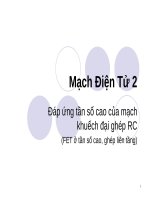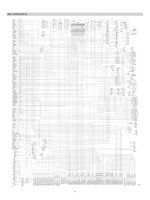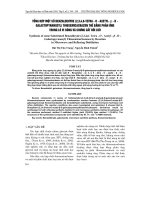Chapter 2 3 protein biosynthesis
Bạn đang xem bản rút gọn của tài liệu. Xem và tải ngay bản đầy đủ của tài liệu tại đây (1.23 MB, 41 trang )
Protein biosynthesis
04/25/2023
by TDLV
1
The Central Dogma of Life
replication
04/25/2023
by TDLV
2
Protein Synthesis
• Genetic information: the form of specific
sequences of nucleotides along the DNA strands
• The DNA inherited leads to specific traits by
dictating the synthesis of proteins
• Protein Synthesis: includes two stages:
transcription and translation
04/25/2023
by TDLV
3
Transcription and Translation
• Transcription
– the synthesis of RNA under the direction of DNA
– Produces messenger RNA (mRNA)
• Translation
– the actual synthesis of a polypeptide under the direction
of mRNA
– Occurs on ribosomes
04/25/2023
by TDLV
4
Transcription and Translation
• In prokaryotes, transcription & translation
occur together
TRANSCRIPTION
DNA
mRNA
Ribosome
TRANSLATION
Polypeptide
04/25/2023
(a) Prokaryotic cell. In a cell lacking a nucleus, mRNA
produced by transcription is immediately translated
without additional processing.
by TDLV
5
Transcription and Translation
• In a eukaryotic cell, the nuclear envelope separates
transcription from translation
• Extensive RNA processing occurs in the nucleus
Nuclear
envelope
DNA
TRANSCRIPTION
Pre-mRNA
RNA PROCESSING
mRNA
Ribosome
TRANSLATION
(b) Eukaryotic cell. The nucleus provides a separate
compartment for transcription. The original RNA
transcript, called pre-mRNA, is processed in various
ways before leaving the nucleus as mRNA.
Polypeptide
04/25/2023
by TDLV
6
Transcription
• Product/catalysis/materials/
steps
• Transcription is the DNAdirected synthesis of mRNA
• RNA synthesis
– catalyzed by RNA polymerase
– Follows the same base-pairing
rules as DNA, except that in
RNA, uracil substitutes for
thymine
04/25/2023
by TDLV
7
TRANSCRIPTION - OVERVIEW
Transcription
- when a cell requires a particular protein specific mRNA synthesized
- first, a section of DNA containing the gene unwinds
- only one of the DNA strands copied (at the initiation point: sequence TATAAA)
- RNA polymerase: moves along DNA template in the 3’-5’direction replicates DNA sequence
into a complementary sequence of mRNA
- mRNA synthesized using complementary base pairing with uracil (U) replacing thymine (T)
moves out of the nucleus to ribosomes in the cytoplasm, acts as the template for protein
biosynthesis (translation) and the DNA re-winds
released at the termination point
RNA
• Types/functions
• RNA is single stranded, not double stranded like DNA
• RNA is short, only 1 gene long, where DNA is very long and contains
many genes
• RNA uses the sugar ribose instead of deoxyribose in DNA
• RNA uses the base uracil (U) instead of thymine (T) in DNA.
04/25/2023
by TDLV
9
Synthesis of an RNA Transcript
• The stages of
transcription:
– Initiation
– Elongation
– Termination
04/25/2023
by TDLV
10
Synthesis of an RNA Transcript - Initiation
• Promoters signal the
initiation of RNA synthesis
• Transcription factors help
eukaryotic RNA polymerase
recognize promoter
sequences
• A crucial promoter DNA
sequence is called a TATA
box.
1 Eukaryotic promoters
TRANSCRIPTION
DNA
RNA PROCESSING
Pre-mRNA
mRNA
TRANSLATION
Ribosome
Polypeptide
5
3
Promoter
3
5
T A T A A AA
AT AT T T T
TATA box
Start point
2
Template
DNA strand
Several transcription
factors
Transcription
factors
5
3
3 Additional transcription
factors
RNA polymerase II
5
3
Transcription factors
3
5
5
RNA transcript
Transcription initiation complex
04/25/2023
3
5
by TDLV
11
Synthesis of an RNA Transcript - Elongation
•
•
RNA polymerase synthesizes a single strand of RNA against the DNA template
strand (anti-sense strand), adding nucleotides to the 3’ end of the RNA chain
As RNA polymerase moves along the DNA, it continues to untwist the double
helix, exposing about 10 to 20 DNA bases at a time for pairing with RNA
nucleotides
Non-template
strand of DNA
Elongation
RNA nucleotides
RNA
polymerase
3
C
C
A
A T
3 end
T
U
C A
E
G
C
A
T
A
G
G
T
Newly made
RNA
by TDLV
T
U
A
T
Direction of transcription
(“downstream”)
5
04/25/2023
C
G
5
T
G
A
A
A
A
C
G
Template
strand of DNA
12
Synthesis of an RNA Transcript - Termination
•
Specific sequences in the DNA signal
termination of transcription (TAA, TAG, TGA)
•
When one of these is encountered by the
polymerase, the RNA transcript is released
from the DNA and the double helix can zip
up again.
04/25/2023
by TDLV
13
Post Termination RNA Processing
•
Most eukaryotic mRNAs aren’t ready to be translated into protein directly after
being transcribed from DNA. mRNA requires processing.
•
RNA processing occur in the nucleus. After this, the messenger RNA moves to the
cytoplasm for translation.
•
The cell adds a protective cap to one end, and a tail of A’s to the other end.
These both function to protect the RNA from enzymes that would degrade
•
Most of the genome consists of non-coding regions called introns
– Non-coding regions may have specific chromosomal functions or have regulatory
purposes
– Introns also allow for alternative RNA splicing
•
Thus, an RNA copy of a gene is converted into messenger RNA by doing 2 things:
– Add protective bases to the ends
– Cut out the introns
04/25/2023
by TDLV
14
Alteration of mRNA Ends
• Each end of a pre-mRNA molecule is modified in a
particular way
– The 5 end receives a modified nucleotide cap
– The 3 end gets a poly-A tail
A modified guanine nucleotide
added to the 5 end
TRANSCRIPTION
50 to 250 adenine nucleotides
added to the 3 end
DNA
Pre-mRNA
RNA PROCESSING
mRNA
5
Protein-coding segment
G P P P
Polyadenylation signal
AAUAAA
3
AAA…AAA
Ribosome
TRANSLATION
5 Cap
Polypeptide
04/25/2023
5 UTR
Start codon Stop codon
by TDLV
3 UTR
Poly-A tail
15
RNA Processing - Splicing
• The original transcript
from the DNA is called premRNA.
• It contains transcripts of
both introns and exons.
• The introns are removed
by a process called splicing
to produce messenger
RNA (mRNA)
04/25/2023
by TDLV
16
RNA Processing - Splicing
• Ribozymes are catalytic RNA molecules that function
as enzymes and can splice RNA
• RNA splicing removes introns and joins exons
5 Exon Intron
TRANSCRIPTION
RNA PROCESSING
DNA
Pre-mRNA
Intron
Exon
Exon
3
Pre-mRNA 5 Cap
1
Poly-A tail
30
31
Coding
segment
mRNA
Ribosome
104
105
146
Introns cut out and
exons joined together
TRANSLATION
Polypeptide
mRNA 5 Cap
1
3 UTR
04/25/2023
by TDLV
Poly-A tail
146
3 UTR
17
RNA Processing - by spliceosomes
• RNA Splicing can also be carried out by spliceosomes
04/25/2023
by TDLV
18
Alternative Splicing (of Exons)
• How is it possible that there are millions of human
antibodies (proteins) when there are only about
30,000 genes?
• Alternative splicing refers to the different ways
the exons of a gene may be combined, producing
different forms of proteins within the same genecoding region
• Alternative pre-mRNA splicing is an important
mechanism for regulating gene expression in
higher eukaryotes
04/25/2023
by TDLV
19
Protein – modular structure
• Proteins often have a modular architecture
consisting of discrete structural and functional
regions called domains
• In many cases, different exons code for the
different domains in a protein
DNA
Gene
Exon 1
Exon 2
Intron
Intron
Exon 3
Transcription
RNA processing
Translation
Domain 3
Domain 2
Domain 1
04/25/2023
by TDLV
Polypeptide
20









